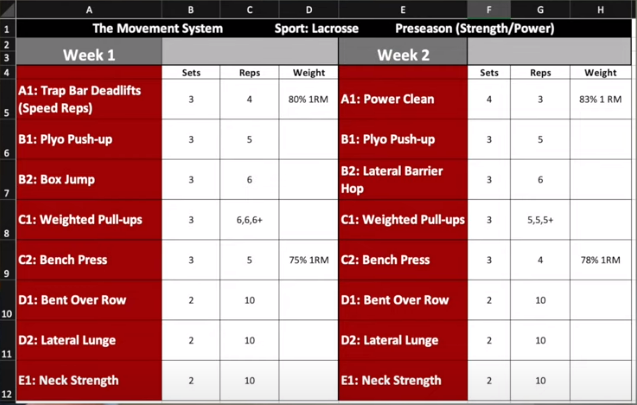CSCS Program Design | Strength, Power, Hypertrophy, & Endurance
Aug 07, 2022
Edited by: Danielle Abel
How to Program Based on % of 1RM
When it comes to the CSCS exam, you should be thinking about the given components of a training program, meaning the exercises and the sets and reps. Don't get confused between program design and periodization; periodization is more about the overall framework of training related to the training goals from the big picture and is associated with the principles of progression.
Percent of 1RM and Repetitions Allowed
For each given repetition, the National Strength and Conditioning Association (NSCA) assigns the number of allowed repetitions to help coaches in selecting a load that is appropriate for the athlete, based on their 1RM test or their estimated 1RM.
This chart comes from the 4th edition of the NSCA's textbook, Essentials of Strength and Conditioning, Table 17.7.

This table shows how many reps an athlete should be able to perform at any given percentage of 1 rep max. Knowing that they can, though, doesn't mean that you should - in order to prevent too much fatigue accumulation, trainers and coaches should program fewer reps than max. For example, instead of 8 reps at 80% 1RM, maybe you program 8 reps at 70% 1RM.
Load and Repetition Assignments
Load and repetitions should be assigned based on the goals of the athlete or the primary needs of their sport.
A reference to help you establish these ranges is on page 458, Table 17.9 of Essentials of Strength and Conditioning (4th edition).

Knowing that an athlete could do 8 reps of their 1RM, it makes sense that a strength athlete should be doing 6 reps or fewer of their 1RM since when programming, you typically won't be programming them at their 1RM. So when you compare the percentage of 1RM chart and the load and repetition assignment chart it should start to make more sense.
For power athletes we want to stay at about 50% of their 1RM, knowing that velocity is important for these athletes, meaning the speed at which they can move a load. For example, 4 reps at an 80% 1RM, knowing that they could do 8 reps, but cutting this in half to 4 reps.
For hypertrophy athletes keeping the load at 75% of 1RM, with say 8 reps, would keep them below their maximum of 8 reps at 80% and would keep the rep range between the recommended 6-12. This would be very similar to an RPE 8 if you're using rating of perceived exertion.
A good rule of thumb to keep the athlete from burning out is to program 1-2 reps below what they can do.
For endurance athletes keeping the work below 67% is ideal due to the number of repetitions to be performed. For example, 15 repetitions at 60% of 1RM.
Practical Application
Applying these concepts is much easier to understand when you can see them applied in an actual training program.

This is a preseason lacrosse training program. You can see starting in Week 1 the athlete would be focusing on speed reps, knowing this is preseason, and this is a strength & power phase of training, speed reps makes sense.
- For the trap bar deadlifts, 80% 1RM and 4 reps support the power style programming by going for about 50% of 1RM. Knowing that the athlete could do 8 reps, we're cutting this in half to 4 reps.
Also of note is the straight set and superset combination. For trap bar deadlift, we would want the athlete to rest between those sets, whereas for the push-ups and box jumps, they would rest after performing both of these exercises.
- The push-ups and box jumps are designed to promote quick speed and aren't loaded. Knowing that the athlete is in the preseason and is also training for their sport, we would want to be mindful of load and volume.
The weighted pull-ups and bench press are superset together to promote power, with the load being bodyweight only and the reps being 6+ (a burnout set or as many reps as possible) on the last set of pull-ups and 75% of 1RM for the bench press. Knowing that an athlete could do 10 reps at 75, we're cutting that to 50% for power.
Lastly the row and lateral lunge is programmed as an accessory, so it's not as important to be in the power rep range like you would be for your main training movements.
Overall Concept & Summary
When designing a program, the first 4-6 exercises, in general, should support the primary objective of the training (ie: power, strength, etc.), and then accessories can be programmed in a 10-12 rep range if desired.
Progressions week to week should support the goal of the training program. So, for example, in the above lacrosse preseason program, you can see that the intensity is going up (78& of 1RM) and the volume is coming down (4 reps). The idea of increasing intensity and decreasing volume is an example of linear periodization. Remember, program design is an exact science, so use the recommendations available to you knowing that you can always adapt and adjust the more experience that you gain.
Support & Courses Available
Ready for more support to help you prep for the CSCS exam? Join our Facebook Group “Strength and Conditioning Study Group” here.
Ready for even more? Our 24 module CSCS Prep Course has program design for athletes completely laid out for you with even more content than what we’ve provided here, plus chapter quizzes to help you pass the NSCA exam, click the link here to check it out.
Stay connected with news and updates!
Join our mailing list to receive the latest news and updates from our team.
Don't worry, your information will not be shared.
We hate SPAM. We will never sell your information, for any reason.

